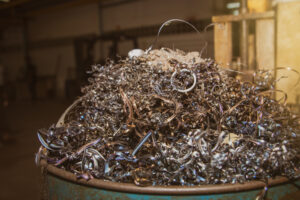Insights into achieving carbon neutrality in additive manufacturing 🌱

Additive Manufacturing and Sustainability
Of all the buzzwords associated with AM, no topic is hotter right now than sustainability. Most of us are aware that, relative to traditional manufacturing, the additive manufacturing carbon footprint is far lighter. But in this blog, we’ll look closer at additive manufacturing and sustainability, while considering how companies using AM technology can drive down their environmental impact.
The state of sustainability
Why is sustainability at the forefront of manufacturers’ minds in 2025? Well, it’s an interesting mix of social conscience and cold, hard legislation. Back in November 2022, the European Council launched a new requirement requiring European firms to report any indirect emissions from across their entire value chain (also referred to as Scope 3 emissions).
In short, there’s now a heavy onus on manufacturers to measure and disclose any greenhouse gas emissions resulting from their activity, from product waste to transportation and distribution. No wonder the subject is now in sharp focus – and investment in sustainability on a high. But where should companies start?
Bottom line: the smartest way for a business to address its Scope 1, 2 and 3 emissions is to make a firm commitment to AM technology. At 3D Print Bureau, we’re serious about sustainability (in fact, our Midlands headquarters is entirely carbon-neutral), and we play our part by delivering optimal AM results that are also environmentally sound. So let’s look at some of the ways in which additive manufacturing and sustainability go hand-in-hand.
Addition, not subtraction
Watch a 3D printer in action and you’ll quickly grasp the fundamental reason why AM has the edge over conventional manufacturing when it comes to sustainability. As the name suggests, additive manufacturing builds parts layer-by-layer, producing only what is required by the design.
This stands in direct contrast to subtractive manufacturing, which typically sees a milling machine carve or hollow out a solid block to produce the desired object. Compare the amount of discarded material and there’s simply no comparison – it’s reported that AM can generate as much as 70-90% less waste than conventional processes like CNC machining.

Better still, at 3D Print Bureau, we have all the most accurate and efficient 3D printers at our fingertips – so you can be confident you’ll achieve the best results alongside the lightest carbon footprint.
Sharper design, fewer mistakes – less waste
But smarter sustainability starts long before you power up the 3D printer. In years gone by, manufacturers were often flying blind, designing parts based on educated guesses and only realising they fell short once they finally had the prototype in their hands. Often, it would be a case of returning to the drawing board, again and again, with more material wasted each time.
Additive manufacturing has changed all that. With CAD-based design allowing an unprecedented level of precision, it’s now possible to identify and correct potential errors or real-world weaknesses before the print run even begins – ensuring there are no aborted iterations to be thrown out as scrap.
At 3D Print Bureau, we can also help you optimise your design, ensuring it not only excels in form and function – but meets sustainability targets too.
3D Printing Materials: Why they matter
One of the most heartening breakthroughs for additive manufacturing and sustainability is the sheer breadth of materials now available for 3D printing. Some of the most forward-thinking companies out there are throwing serious R&D at producing materials that are both tailor-made for a given application, designed to satisfy environmental targets and eminently easy to recycle.
You’ll see this philosophy in the growing array of sustainable materials now available, exemplified by biodegradable and compostable options like polylactic acid (PLA), which is derived from renewable resources and, unlike plastic, breaks down naturally over time. It’s just one of the countless materials we can offer for your next print run at 3D Print Bureau (while you can also rely on us to pair the optimal materials with compatible 3D printer technology).
Travelling light
At every stage of the product’s lifecycle, AM makes a convincing case for carbon neutrality. Take the matter of inventory. Using old-school manufacturing methods, it was necessary to produce components at volume, then store them in a warehouse until they shipped. Factor in the lighting, heating and physical footprint required to do this and it’s not exactly a triumph for sustainability.

With AM, however, manufacturers can avoid physical warehouses altogether, rapidly printing parts on demand in any location around the world. In turn, this leads to a reduced reliance on transportation. Forget about gas-guzzling trucks ferrying components thousands of miles: all that’s required is to send the CAD file to a company print lab anywhere in the world.
How can companies optimise additive manufacturing to make their business more sustainable?
Adopting additive manufacturing into your business is a great first step – but with smarter use of this technology, you’ll really start to see the results. From optimising design for sustainability (eg. using lightweight lattices rather than solid parts) and pairing the most appropriate 3D print technology with carefully chosen materials, additive manufacturing and sustainability grow ever closer.
There are many factors to consider – but at 3D Print Bureau, we’re on hand to guide you through the process from initial design to final product.
At 3D Print Bureau, we’re serious about reducing the additive manufacturing carbon footprint.
Whether you’re an experienced AM practitioner or taking your first steps into this exciting sector, partnering with 3D Print Bureau ensures the best results for your next 3D printing run. With our state-of-the-art facilities and comprehensive range of 3D printing services, we’re ready to take on your project.
For all your 3D printing needs, contact the team on 01782 757320 or complete our contact form

